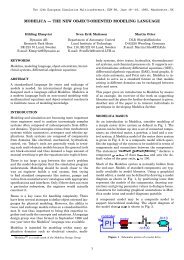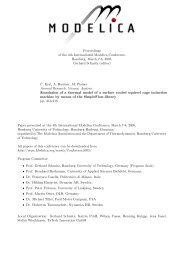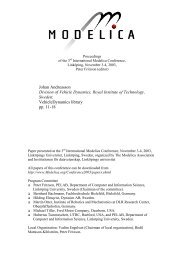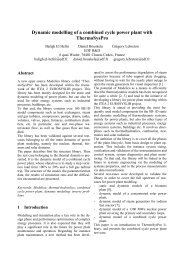Hilding Elmqvist, Hubertus Tummescheit and Martin Otter ... - Modelica
Hilding Elmqvist, Hubertus Tummescheit and Martin Otter ... - Modelica
Hilding Elmqvist, Hubertus Tummescheit and Martin Otter ... - Modelica
Create successful ePaper yourself
Turn your PDF publications into a flip-book with our unique Google optimized e-Paper software.
H. <strong>Elmqvist</strong>, H. <strong>Tummescheit</strong>, M. <strong>Otter</strong> Object-Oriented Modeling of Thermo-Fluid Systems<br />
(h_start – h0)/cp_air;<br />
parameter h_start2 =<br />
if init_T then<br />
cp_air*T_start + h0<br />
else h_start;<br />
parameter p_start2 =<br />
if init_p then<br />
p_start<br />
else R_air*d_start*T_start2;<br />
parameter d_start2 =<br />
if init_p then<br />
p_start/(R_air*T_start2)<br />
else d_start)<br />
public<br />
extends(<br />
p(start = p_start2, stateSelect=..,),<br />
T(start = T_start2, stateSelect=..,),<br />
d(start = d_start2),<br />
h(start = h_start2),<br />
u(start = h_start2 – p_start2/<br />
d_start2)<br />
);<br />
constant Real R_air = 287.0506;<br />
constant Real cp_air = 1005.45;<br />
constant Real h0 = 274648.7;<br />
Above is the first part of the initialization. In the<br />
extends clause of the BaseProperties model together<br />
with the new protected Section, start values for all<br />
variables are calculated from the given start values.<br />
This requires to evaluate the medium equations with<br />
the given start values. In situations with more<br />
complex equations, it is often useful to define them<br />
with functions <strong>and</strong> call the functions for start value<br />
calculation <strong>and</strong> in the equation section. The reason<br />
to provide consistent start values for all variables is<br />
that these variables are potentially iteration variables<br />
in non-linear algebraic loops <strong>and</strong> need therefore<br />
reasonable guess values. It is not known beforeh<strong>and</strong><br />
which iteration variable the symbolic translator will<br />
select. In the remaining code, the initialization<br />
equations <strong>and</strong> the medium equations are defined:<br />
initial equation<br />
if preferedMediumStates then<br />
if initType == C.InitialStates then<br />
p = p_start2;<br />
T = T_start2;<br />
elseif initType==C.SteadyState then<br />
0 = der(p);<br />
0 = der(T);<br />
elseif initType == C.SteadyMass then<br />
0 = der(p);<br />
T = T_start2;<br />
end if;<br />
end if;<br />
equation<br />
p = d*R_air*T;<br />
h = cp_air*T + h0;<br />
u = h – p/d;<br />
end BaseProperties;<br />
...<br />
end SimpleAir;<br />
Initial equations are only provided if<br />
preferedMediumStates = true, i.e., if medium<br />
variables should be used as states. Depending on<br />
parameter initType, the different initialization<br />
equations are defined. These equations depend on<br />
the independent variables of the medium model.<br />
5.4 Multiple Substance Media<br />
Media that consist of several (non-reacting)<br />
substances are both supported from the<br />
<strong>Modelica</strong>_Media <strong>and</strong> the <strong>Modelica</strong>_Fluid library. In<br />
<strong>Modelica</strong>_Media essentially the mass fractions X of<br />
the substances are used as independent variables to<br />
compute the medium properties. Two common<br />
approaches are supported by the <strong>Modelica</strong>_Media<br />
library:<br />
• From the n substances, n-1 substances are<br />
treated as independent, i.e., n-1 mass fractions<br />
are additional independent variables. If needed,<br />
the n-th mass fraction is computed from the<br />
algebraic equation X_n = 1- sum(X[1:n-1]).<br />
• All n substances are treated as independent<br />
during simulation, i.e., n mass fractions are used<br />
as independent variables <strong>and</strong> there are n<br />
additional substance mass balance equations.<br />
Since the constraint that the mass fractions sum<br />
up to one, is not utilized, a slight drift of the<br />
mass fractions may occur. Of course, the initial<br />
mass fractions have to be defined such that they<br />
are summed up to one (this is checked in the<br />
PartialMedium package).<br />
In order to not have special cases, the<br />
<strong>Modelica</strong>_Media <strong>and</strong> Modelcia_Fluid libraries<br />
define the constant “nX” of PartialMedium to be the<br />
“number of independent” mass fractions. This might<br />
be n-1 or n substances of a multiple substance<br />
medium. In order to be able to make some checks,<br />
such as for initialization, the constant “reducedX”<br />
must be defined. If true, nX characterizes n-1<br />
substances, if this flag is false, nX characterizies n<br />
substances.<br />
Note, for single substance media, no mass<br />
fraction vector or substance mass flow rate vector is<br />
present, because nX = 0 in this case <strong>and</strong> zero sized<br />
vectors are removed in the code generation phase.<br />
6 Medium Models in<br />
<strong>Modelica</strong>_Media<br />
In this Section, some of the more advanced medium<br />
models available in the <strong>Modelica</strong>_Media package<br />
are discussed in more detail. All of them are based<br />
on the medium interface described in the last<br />
Section.<br />
The <strong>Modelica</strong> Association <strong>Modelica</strong> 2003, November 3-4, 2003

















